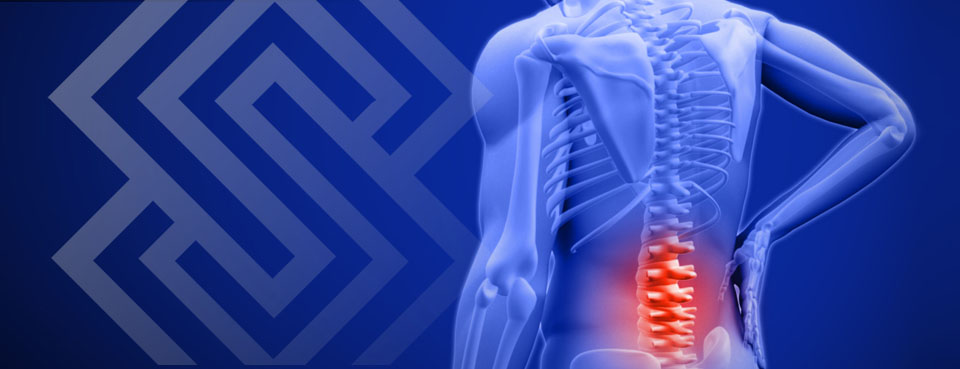Scoliosis
Scoliosis is defined as a sideways curvature in the normally straight vertical path of the spine and is a common spinal condition affecting a large percentage of the US population, including approximately 2% – 3% of Americans aged 16. Scoliosis often times appears prior to puberty and females tend to developing scoliosis more often than males.The four primary types of scoliosis:
• Neuromuscular Scoliosis
Resulting from reduced muscle or nerve function, this form of scoliosis is usually seen in those cases presenting with cerebral palsy, spina bifida or other conditions that are accompanied by paralysis. Neuromuscular scoliosis is also commonly referred to as myopathic scoliosis.
• Degenerative Scoliosis
Degenerative scoliosis typically begins with progression of osteoporotic conditions that precipitate the decline of bone density and mass, and can be accelerated or exacerbated by aging and wear. Acute injury or trauma can also cause this type of scoliosis. Normally occurring later in life, it is one of the few types of scoliosis that otherwise healthy patients may first experience during adulthood.
• Congenital Scoliosis
Patients born with bone abnormalities can develop congenital scoliosis. This disease develops in utero and presents during infancy. Congenital scoliosis is very rare, affecting only one in 10,000 live births. However, those who suffer from this condition will require corrective surgery.
• Idiopathic Scoliosis
This type of scoliosis originates from no known causes. Research evidence suggests that this type of scoliosis may be inherited and is genetic. The severity of scoliosis depends upon the shape, location and direction of the curvature of the spine. Curves or arcs are generally described as either S-shaped or C-shaped.
Terms used to indicate the details of a specific curvature:
• Dextroscoliosis
The most frequently occurring type of spinal curve, dextroscoliosis develops when the spine bends toward the right. This usually happens in the thoracic middle area of the spine and may be isolated forming a C shape or be accompanied by another curve moving in the opposite direction in the lower spine creating an S shape.
• Levoscoliosis
A spinal curve to the left, levoscoliosis usually surfaces in the lumbar lower back area of the spine. When levoscoliosis occurs in the middle back thoracic area of the spine it may indicate a spinal cord tumor. For this reason, it is important to diagnose levoscoliosis as soon as possible.
• Thoracic Scoliosis
In the majority of scoliosis cases, curvature occurs in the middle thoracic spine. Thoracolumbar Scoliosis involves the vertebrae in both the lower thoracic spine and the upper lumbar spine.
Scoliosis Causes
Many causes of scoliosis can be easily managed, but others can be dangerous and require timely medical attention. By evaluating the spinal curve and performing non-invasive tests, spine specialists can typically determine the underlying cause and then create a plan for treatment tailored for each individual case.
Common causes include:
• Congenital abnormality.
• Genetic predispositions.
• Cerebral palsy.
• Muscular dystrophy.
• Osteoporosis.
• Aging.
• Bone degeneration.
• Sudden injury, trauma or accident.
• Spinal Infections.
• Benign or malignant tumors.
Scoliosis Symptoms
Scoliosis can occur gradually and may not be accompanied by any immediate pain. Therefore it can be difficult to recognize early on. Addressing scoliosis promptly can increase chances of obtaining effective treatment and recovering or maintaining quality of life.Scolisois symptoms include:
• The spine appears curved.
• One shoulder is resting higher than the other.
• One shoulder blade protrudes outward more than the other.
• One hip appears higher and/or protrudes than the other.
• The waist appears uneven with one side carried higher than the other.
• Dull or sharp back pain is experienced and is intermittent or persistent.
• One leg appears shorter than the other.
• The body leans to one side with one arm hanging lower than the other.
• Difficulty breathing (in progressive cases)
If you have trouble breathing, experience decreased mobility or extreme pain, seek emergency medical attention.
Notice:
This advertisement has been provided for informational purposes only and should not be used as a substitute for medical treatment or an actual diagnosis. If you are experiencing pain that may be associated with back or neck disorders you should seek the care of a doctor as soon as possible or immediately if your symptoms are accompanied by incontinence / loss of bladder or bowel control, as these may be signs of life threatening condition.

